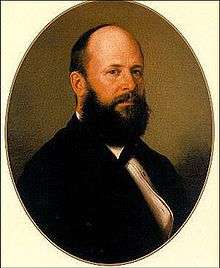Konstantin Vojnović
Konstantin "Kosta" Vojnović (Serbian Cyrillic: Константин Војновић; Serbian pronunciation: [konstǎntin kôsta ʋǒːjnoʋit͡ɕ]; March 2, 1832 – May 20, 1903) was a Croatian Serb politician, university professor and rector in the kingdoms of Dalmatia and Croatia-Slavonia of the Habsburg Monarchy.

Life
Family
Vojnović was born in Herceg Novi (Kingdom of Dalmatia, modern Montenegro) into the Serb Vojnović noble family. His grandfather Đorđe Vasiljević Vojinović (1760-1821) was a Russian military officer, he later returned to Boka Kotorska, and in 1800, in Ancona, he married Kasandra Angeli-Radovani from a Roman Catholic family. They had a son, Jovan. Count Jovan Đ. Vojinović (1811-1837) died at the age of 26, he married Katarina Gojković whose mother was of the family of Serbian Orthodox Metropolitan Stevan Stratimirović. Katarina later remarried to a Pelegrini. Jovan and Katarina had two sons, Konstantin (Kosta), and his brother Đorđe (Đura).
His brother Đorđe (1833-1895) was the mayor of Boka (1863-1877) and its representative deputy, and president of the Diet of Dalmatia in Zadar. As the people's deputy he fought against the Austrian politics that deliberately omitted the Bokan maritime affairs, which was the main occupation of his ancestors.
Konstantin and Đorđe were baptized in the Serbian Orthodox Savina monastery in Herceg Novi, however, their grandmother Kasandra later converted them into the Roman Catholic confession.[1]
Career
He graduated law at the University of Vienna in the period 1851-54, received his Ph.D. in Padua in 1856. In Split he worked as a lawyer, a secretary of the Chamber of Merchants, legislative writer and a politician. He advocated unification of Dalmatia and Istria with Croatia and Slavonia. He was great supporter of Croatian independence in Austria-Hungary. As a member of the People's Party, he served as a representative in the Parliament of Dalmatia. At the recommendation of his close friend and a colleague Josip Juraj Strossmayer, he was elected in 1874 as a professor of Austrian law at the University of Zagreb.
He served twice as a prorector of the university: the first time during the rectorship of the first rector Matija Mesić, and the second time immediately after himself served as a rector in the academic year 1877/1878. In the period 1878-1884 he served as a representative in the Croatian parliament. He was a full member of the Yugoslav Academy of Sciences and Arts since 1890. Due to political reasons, expressing his disagreement with oppressive Magyarization, he was temporarily suspended from university service and retired in 1891. He returned to Dubrovnik and began research of the Dubrovnikan legislative history. He died in Dubrovnik at the age of 71.
Marriage and children
He married Marija Seralji (Serragli; 1836-1922) from Dubrovnik in 1855. She was the daughter of Luigi de Serragli (1808-1902), an Italian businessman and bureaucrat, member of the Dalmatian Diet, and Kristina Đivović.
They had five children: Ivo, Lujo, Katica, Eugenija and Kristina.
Legacy
Since 1933 a street in Zagreb is named after him.
References
- Martinović 2003, footnotes: "Đorđev sin Jovan imao je dva sina: Kostu i Đura, koji su bili kršteni u manastiru Savini kod Herceg-Novog, ali ih je docnije njihova baba Angeli-Radovani prekrstila u katoličku vjeru."
- Dušan J. Martinović (2003). "Admirali i generali Vojnovići u ruskoj vojsci". Project Rastko Boka (in Serbian). Retrieved 2010-11-22.
- Vojnović's biography, at the University of Zagreb website
| Academic offices | ||
|---|---|---|
| Preceded by Anton Kržan |
Rector of the University of Zagreb 1877 – 1878 |
Succeeded by Franjo Maixner |